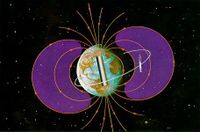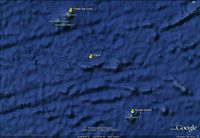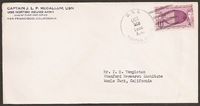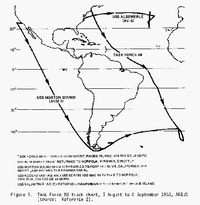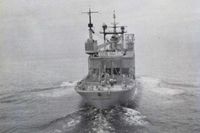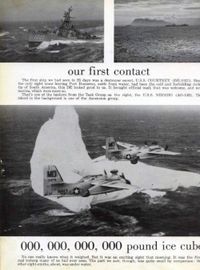Tristan da Cunha - Operation ARGUS
Nuclear Bomb exploded near Tristan da Cunha in 1958
-- published in the South Atlantic Chronicle February 2012 - SHATPS
Operation Argus was the only clandestine nuclear test series in the 17 years history of atmospheric testing. It was secretly conducted in the South Atlantic close to one of our 3 islands – Tristan da Cunha.
The tests
The test were proposed by a scientist of the Lawrence Radiation Laboratory to verify a theory, which argued that high-altitude nuclear detonations would create a radiation belt in the extreme upper regions of the Earth's atmosphere by interacting with the magnetic field of earth. Such belts would be similar in effect to the Van Allen radiation belts. The radiation belts were viewed as having possible tactical use in war, and could potentially interfere with radar tracking, communications, and the electronics of satellites and ballistic missiles.
And such an artificial van Allen radiation belt, a radioactive shield, should be created by Operation Argus – and I anticipate – the world greatest scientific experiment succeeded (as we know and can hope).
But why in the South Atlantic? Due to the South Altantic Anomaly, the Van Allen radiation belt is closer to the earth's surface near the magnetic poles. The (extreme) altitude of the tests was chosen so as to prevent personel involved in the test from being exposed to any ionizing radiation. Additional effect - the remote South Atlantic region granted great secrecy.
When I heard for the first time of nuclear tests in the South Atlantic, I wanted to know where these tests were conducted – and if the people living in that area were impacted by nuclear fallout.
Three ballistic missile launches were started with detonations in high altitude. Later a peak fallout was measured.
The first launch was in Tristan waters (see map and list below) and the 2nd and 3rd launches were approximately between Gough and Bouvet Island, about 1.000 km south of Gough.
Task Force 88 and ship movements in Tristan waters
In April 1958 the Task Force 88 was formed to conduct Operation Argus.
The USS Norton Sound was responsible for missile-launching functions.
The USS Tarawa served as overall command of the operation. She housed 19 Grumman S-2F aircrafts and Sikorsky HSS-1 Seabat Helocopters, responsible for transport between the units of Task Force 88.
Further ships of the Task Force 88 were the USS Warrington, in conjunction with the USS Bearss, USS Hammerberg, and USS Courtney and the USS Neosho refueled task force ships during the operation.
List of Argus Launches
- Argus I - 180 km SSE of Tristan da Cunha
Time: 02:28 August 27, 1958 (GMT)
Location: 38.5° South, 11.5° West
Altitude: 124 miles (200 km)
- Argus II – 1.200 km northwest of Bouvet Island
Time: 03:18 August 30, 1958 (GMT)
Location: 49.5° South, 8.2° West
Altitude: 159 miles (256 km)
- Argus III – near Argus II
Time: 22:13 September 6, 1958 (GMT)
Location: 48.5° South, 9.7° West
Altitude: 335 miles (539 km) (perhaps the highest nuclear explosion ever)
More than 4.500 military personnel and civilian scientists participated in the test operation.
At that time, these nuclear tests were very secret. Most islanders of Tristan da Cunha first heard about the tests when the Jennings article was published 2006. Until today it’s very unclear to the public, if even the governments of countries which were affected by Operation Argus were informed by the US Administration as Great Britain and South Africa. Because of such a great accumulation of warships in a region which is British area of interest and near South Africa with its Meteorological Station on Gough Island it seems very unlikely. It’s very probable, that such an enormous fleet with aircrafts and helicopters which operated several weeks near Tristan da Cunha and more south of the Atlantic Ocean could be veiled from the public - even if the Tristan Explosion took place in the very early morning of 27th August 1958 and wasn’t remarked by the Tristanians. At the time of the Argus I launch the fishery vessels Tristania and Francis Repetto were in South Africa waters and arrived at Tristan at 2nd and 4th September with a total of 31 bags of mail. On 5th September the Tristania towed to sea with engine trouble and 2 days later towed back to Cape Town by Francis Repetto for repairs, so no eye-witness was aware of the atomic blast between Tristan and Gough – what an accident for the Task Force 88 ?!? It was winter in the southern hemisphere and no British warship or civilian ship was expected off Tristan da Cunha, surely a fact planned for the operation.
On the other hand some incidents were remarked, but in 1958 nobody was able to integrate such events into a historical context. A mysterious event took place at that time: on 9th September 1958 two or three carrier aircraft with US markings swept by the potato patches, an odd incident and “unfriendly act”. It was the first time in Tristan history of an overfly of aircrafts and no Tristanian has seen aircraft before. The Administrator G.J. Harris mentioned that incident in his quarterly report – 2 unidentified aircraft seen over patches. Most probably these carrier aircraft (Grumman S-2F) came from USS Tarawa. Additional, spinning the dials of the radio receivers, the islanders found the air waves alive with coded signals from many ships which must be near Tristan da Cunha, signals of the unseen fleet operating in the proximity of Tristan da Cunha.
Beyond that, no Tristanian had seen any ship, helicopter, or other aircraft of Task Force 88. Radio calls from Tristan to the unseen fleet remained unanswered.
Eye-witnesses
Bob T., aged 19 in 1958, who served on board of USS Norton Sound during the Argus cruise:
"….The Islands that you write about, I did not see (author: Tristan da Cunha, Gough, Bouvet).
I did see the Ice-berg and I did get to watch the last atomic explosion.
But most of the time I was working below decks…
….We crossed the equator on Aug 7 -1958 and rounded the Horn Aug-17.
We arrived in area about 23 or 24 aug.
I was in charge of all refrigation and air cond, on the ship and my missile quarters station was in the ice machinery area below decks.
I knew early in the year that we were going on this cruise but I didn't know where. I was sent to school in San Diego in feb thru april for air conditioning and refrigeration training.
Some of us were allowed to go topside to see the third explosion. It was pitch black and we had to hold hands to be safe.
We were told to look out and not up to keep from being blinded.
The sky came alive as if it was midday then slowly faded back to total darkness.
As for anxious moments, the only time I remember was on the first firing and after the countdown from ten to zero someone yelled on the bitch box - Misfire misfire and then silence. Finally someone said there was a misfire and not to worry that everything was under control.
That was a little scary….
The first liberty that we made was Rio-de-Janeiro (author: 19 Sep. 1958).
I don't remember the date but I do remember that we had been at sea for 46 days from land to land."
Dick C., aged 22 in 1958 also served on board:
"…Because of the nature of the mission we were not allowed cameras until we reached Rio so I have no pictures. We did have a cruise book but no photos of the missile launch.
We had three missiles to launch and the general “station” was 43° 47’ S and 8° 34’ W (about 400 km sse of Gough, author). We arrived there 25 August 1958. The actual “station” varied and at 27th Aug we launched the first missile. This was at approx 43°43’ S 9°22’ W. At this point the weather deteriorated and the launch was delayed until 30 Aug at 0310 47° 46’ S 7°32’ W. Again the weather moved in and we were in heavy seas for a few days. We were also on the watch for icebergs moving through the area. We spotted one very large one, many times longer that the Norton Sound and the aircraft carrier that was part of Task Force 88. On September 7th we hit a blizzard, rather a series of them and iced the ship up enough the deck crew started clearing ice from the upper deck rigging. Our missile telemetry shop, where I worked, was one of the highest levels on the ship and we used pure grain alcohol to keep our antennas from icing up. At this time we were 50°57’ S and 11°16’ W. Other than when we rounded Cape Horn, this was as far south as we went. We attempted a launch on 5 Sep but too much snow to safely move the missile to the launch pad. The final missile was launched at 2205 6 Sep 1958 at 49°54’ S and 8°19’ W. We had been on station two weeks at that time.
"The X-17 missile was what was referred to as a “nail driver.” It was normally used to test the configuration of warheads when they re-entered the atmosphere. The first stage (it was a three stage rocket) sent it to the edge of the space and when it turned over and started back down the other two stages were fired which brought it to a speed that would burn up poorly designed warheads.... |
I saw all three launches. As I mentioned, our telemetry station was one of the highest points on the ship and once the ITL (Intent To Launch) button was hit, we had no further duties and as soon as the missile left the launcher we went out on the deck (no one was allowed on deck at launch in the event of an explosion). There was cloud cover for each launch and when each of the 2K warheads fired it lit up the sky from horizon to horizon as I recall.
One note of interest might be the tension at launch time. The missile launch system was tied to the ships gyro so it would fire at a specific azimuth. The first launch came 7 min 16 sec AFTER the launch was initiated. The second 7 min 27 sec and the third 7 min 34 sec. As I recall, any more than 10 minutes was considered a potential hang fire, which none of us really wanted to think about.
We immediately started north and, according to my records, between 8 Sep and 9 Sep we were the closest to your island group. St. Helena is listed as 37°6’44” S 12°16’56”W. Our noon sighting 8 Sep was 40°34’ S 8°42’ W. On the 9th it was 36°59’ S 13°33’ W. It would appear that we came the closest some time during that 24 hour period.
We were not supposed to know where we were. One of my best friends was a Quarter Master and he gave me the sightings each day and I didn’t tell anyone. I don’t recall having a map or anyone mentioning there was any land close by. The Falkland Islands were mentioned but this was after our return.
On 15 Sep we entered the harbor in Rio and after a fun week we headed north again. On 23 Sep we split off from the rest of Task Force 88 and stopped in Trinidad before heading for the Panama Canal and home."
(Dick developed cancer 20 years later- by luck he is now cancer free.)
In Rio there was a change of Command of USS Norton Sound. Cap. McCallum took over command from Cap. A.R. Gralla.
Result & reactions of the operation
As a result of the secret operation: the possibility of creating an artificial radiation belt round the earth could be proofen – Operation Argus was successful in the eyes of the US military and the scientists.
While the tests were revealed the following year, the full results and documentation of the tests were not declassified until April 30, 1982 and some aspects are still secret.
Peter Jennings wrote an article about Operation Argus in Gibbons Stamps Monthly in 2006 which was re-printed in the Tristan News at 22nd May 2006. Of course he asked if there had been an atomic radiation cloud fall on Tristan and Gough Island. He knew of many Tristanians who suffer from asthma and he mentioned the mice population of Gough Island growing to abnormally large size. And – he got no answers.
So I asked the now former Administrator of Tristan da Cunha, David Morley (until September 2010), for his knowledge about that operation. In a response he wrote, that the answers to my questions about the impact of such an alleged event are a resounding "no". There are no giant mice and no sign of an unusually high incidence of cancer here. The asthma problem is entirely genetic. Note that, in his reply, the Administrator called Operation Argus "alleged", an indication the British officials don’t want to publish more about that incident. But it seems the islanders of Tristan da Cunha were not affected with a higher mortal rate through cancer - that's a good message!
The Tristanians can consider themselves fortunate that the particles and radioactive isotopes released interacted with the Earth's magnetic field. Probably a strong nuclear fallout was avoided – or distributed round the earth - only by luck? Such unique tests with such unknown nuclear material are always good for a negative surprise! And perhaps Operation Argus was not only secret because of the Cold War?
Not far away from Bouvet Island, another atomic test took place in 1979, the Vela Incident in the Indian Ocean 47° South 40° East. The Vela satellite (the incident was named after the satellite) detected a nuclear explosion and until today it's unclear, who made this test, probably South Africa in conjunction with Israel, another story which has not affected our 3 islands - but think back to Operation Argus.
It seems, the southern hemisphere is a part of our earth where nuclear radiation can be freely emitted, perhaps because most of the possessors of nuclear weapons are at home in the northern hemisphere?
Myths & Legends
Finally, the connection between the myth of Hitler’s Antarctic Base and Operation Argus:
In January-February 1939, a secret German expedition visited Dronning Maud Land, Antarctica, apparently with the intention inter alia of establishing a base there. Between 1943 and 1945 the British launched Operation Tabarin, a secret wartime Antarctic operation with men from the SAS, Britain's covert forces for operating behind the lines, appearing to be involved. In July and August 1945, months after the German surrender, two German U-boats arrived in Argentina. Had they been to Antarctica to land Nazi treasure or officials? In the southern summer of 1946–1947, the US Navy appeared to invade Antarctica using a large force. Operation Highjump was classified confidential. In 1958, three nuclear weapons were exploded in the region, as part of Operation Argus. It could be a nuclear attack against Hitler’s Antarctic Base. Given the initial lack of information about these various activities, it is not surprising that some people would use these pieces of information to construct a myth of a German base existing in Antarctica and of allied efforts to destroy it.
Using background knowledge of Antarctica and information concerning these activities that has been published since 1939, it is demonstrated that: the two U-Boats could not have reached Antarctica because of shortages of fuel; there was no secret wartime German base in Dronning Maud Land; SAS troops did not attack the alleged German base; that the SAS men in the region at the time had civilian jobs and their Operation area was thousands of kilometers away from Dronning Maud Land; Operation Highjump was designed to train the US Navy for a possible war with the Soviet Union in the Arctic, and not to attack an alleged German base in Antarctica - and Operation Argus took place over the ocean more than 2000 km north of Dronning Maud Land and the explosions were in the higher atmosphere. According to the Antarctic snow record there was no radiation fall-out measured in Dronning Maud Land. Activities that were classified have subsequently been declassified (i.e. National Nuclear Security Administration) and it is no longer difficult to separate fact from fancy.
References:
- Wikipedia
- Google Earth
- National Nuclear Security Administration / Nevada Site Office / YouTube video
- Tristan da Cunha Monograph Number 11 by Robin Taylor
- Atom Bomb Explodes above TdC during 1958 by Peter Jennings, published in Gibbons Stamp Monthly and Tristan News 22nd May 2006
- Hitler’s Antarctic Base, https://journals.cambridge.org
- German Antarctica
- Neuschwabenland, www.scienceblogs.de
- Bob T. (71) and Dick C. (74), USA, crew members of USS Norton Sound (full names known by the author)
© 2012-2023 Klaus Hahn
